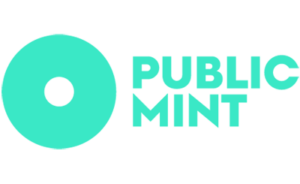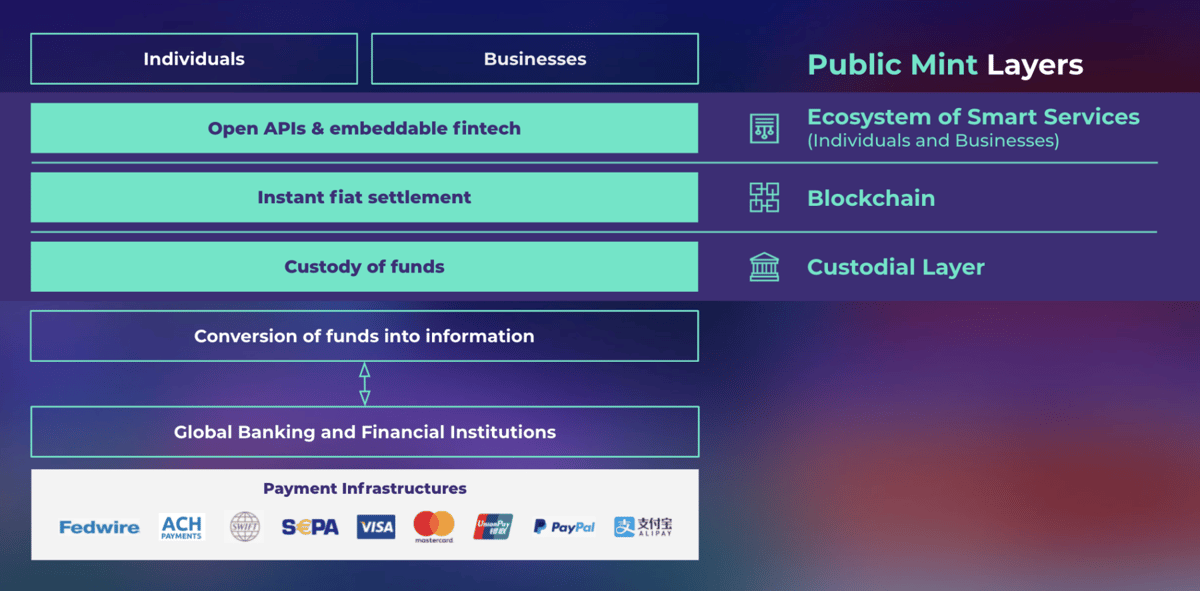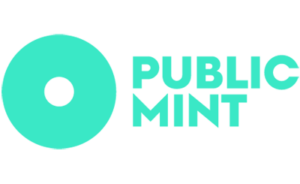Public Mint develops a platform with Hyperledger Besu to make blockchain’s financial benefits accessible to everyone

Public Mint Web Wallet and EARN
- Wallet application with blockchain-mapped synthetic dollars
- One-to-one correlation between on-chain, synthetic dollars and fiat dollars
- Correlated dollars that are fully collateralized with funds held on deposit with FDIC-insured financial institutions
- Option to put funds into high-earning, blockchain-based centralized and decentralized investments
Goals
- Make blockchain-based banking simple for regular users
- Provide users with security and functionality they’re used to
- Provide instant settlement between Public Mint Wallets
- Create an accessible pathway to earning decentralized finance (DeFi) yields
Approach
- Meet users where they are
- Choose a technology platform: Hyperledger Besu
- Launch Public Mint’s Web Wallet
- Introduce DeFi investing to users
The cryptocurrency market will reach nearly five billion USD by 2030, according to recent market research. With impressive returns and projected growth, it’s no wonder people want to get involved in decentralized finance (DeFi).
But for those who don’t already understand crypto assets, there are significant barriers to entry. What’s a wallet? Do I need one, and how do I get one? What are keys? How do I protect them? What platform do I use?
And there’s also the problem of risk. Crypto users have grown comfortable taking chances in the space. But the average person is used to more trust, assurances, and transparency when it comes to their money.
Public Mint, Inc. (Public Mint) envisioned making the blockchain ecosystem more accessible to non-experts by reducing or eliminating its challenges. Ideally, its solution would also allow other companies to more easily transact with their users. Could one platform do both?
Meeting users where they are
Public Mint, a Fintech firm with offices in the US, UK and Europe, decided to create a graduated introduction into blockchain-based investing. “There are really interesting things happening in the finance space with blockchain and cryptocurrencies,” says Paulo Rodrigues, COO of Public Mint. “People should be able to tap into DeFi use cases or their high annual yields. But they’re not available to everyone because the user experience is too challenging for those outside the blockchain space. This does not seem to favor equality.”
So Public Mint began with what users already know: traditional banking and fiat currencies like the US dollar.
The first challenge was uniting blockchain innovations with the regulated fiat currencies people are happy and comfortable using. Public Mint wanted a platform with a one-to-one equivalency between US dollars and a synthetic version of the dollar on their blockchain. This means every synthetic “on-chain” dollar maps to a corresponding US dollar held at one of Public Mint’s regulated custodian partners.
Users would not move dollars from one account to another, the same way traditional banks do. Rather, the physical dollars stay in a custodian bank. Users transfer ownership of these physical dollars using an instant-settlement, low-cost blockchain.
The synthetic dollar is created when someone deposits money into their Public Mint wallet. When someone takes that dollar out of a Public Mint wallet, the synthetic dollar gets destroyed. At the same time, the physical dollar leaves the US custodian account. Then it goes to the location or account specified by its owner per the user’s instructions like a conventional wire or transfer.
This way, Public Mint users could use and move their money, like adding funds or making transfers, in a familiar way. Because the physical dollar is in a regulated custodian partner, like a bank or trust company, users benefit from the same protections of FDIC insurance but without the need for a traditional bank account. To users, the synthetic version of the dollar doesn’t operate much differently than the electronic version of money they’re already used to using when transferring money in current payment systems.
Before Public Mint developed its system, it sought informal feedback on the concept from the Office of the Comptroller of the Currency (OCC). The OCC is an independent bureau of the US Department of the Treasury. According to the OCC website, it “charters, regulates, and supervises all national banks, federal savings associations, and federal branches and agencies of foreign banks.”
The OCC did not point out any fundamental problems, which was enough for Public Mint to get started.
Its next challenge was choosing the technology stack.
“There are really interesting things happening in the DeFi space with blockchain and cryptocurrencies. But they’re not available to everyone… And that doesn’t favor equality.”
Choosing the technology, now Hyperledger Besu
The company experimented with the blockchain technologies available in 2018. Eventually, it decided on an Ethereum-based technology stack called Pantheon developed by the Pegasys team at ConsenSys. For Public Mint, tapping into the large community of Ethereum developers was an important part of the decision.
About a year afterward, Pantheon became Hyperledger Besu, an open source project under the umbrella of the Hyperledger Foundation.
“We were quite pleased,” explains Rodrigues. “We’d selected the best tech stack available according to our requirements, and we were now closer to the Hyperledger end-to-end users and corporate community.”
Public Mint’s platform provides an Ethereum-compatible blockchain but without using its native currency, Ether. “We’ve created a fork out of Hyperledger Besu, in the sense that we’re running like the main Ethereum network, but we don’t run with Ether,” Rodrigues says. “Instead of using a volatile crypto asset, we run natively in US dollars.” Because of this, developers can utilize Public Mint’s developer portal to build on top of the system, enabling them to provide services using USD to reach a much bigger audience.
The Public Mint Platform has multiple layers. There’s the custodial structure, where the banks and trust companies hold the US dollars. Then there’s the technological layer, which manages the synthetic dollars.
“Public Mint doesn’t touch the funds,” explains Rodrigues. “We’re a FinTech company. We created the technology that allows synthetic versions of dollars to settle instantly between parties. The real dollars are safe in regulated entities like banks and trust companies.” This is why the underlying dollars are fully collateralized with funds held on deposit with FDIC-insured financial institutions.
“It’s like the main Ethereum network, but instead of using a volatile crypto asset, we run natively in US dollars.”
Launching the Public Mint’s Network to Users
Public Mint’s network launched in July 2020 with its web wallet payment system. Users create a wallet and go through a Know Your Customer (KYC) process. KYC includes providing a driver’s license and other information required for a regulated bank account.
Once users create the wallet, they can deposit funds using wire, ACH, or stablecoins. Deposits from credit cards are coming soon. Users can start with as little as a dollar; there are no minimum deposit amounts.
At the time of publishing, more than 3,800 wallet addresses have been created since Public Mint’s launch. It has more than USD$2.9 million in on-chain value, and the platform has validated more than 28,000 transactions.
The web wallet interface is similar to traditional banking apps. And Public Mint works on new features all the time.
Introducing DeFi Investing to Users
One of these new features is the EARN Program. EARN is for users who want to take the next step into DeFi investing but don’t want to manage multiple wallets or private keys.
The program creates a way for users to take advantage of this investment potential without learning about blockchain technologies. Instead, the experience is almost like using a savings account with a simple and familiar user interface. Users can allocate traditional dollars into their EARN fund and benefit from additional earnings.
EARN is similar to a money market account in that users can always withdraw funds. It’s also like a mutual fund in that the dollars in an EARN account get invested into multiple CeFi partners and/or DeFi protocols. These providers are initially chosen, vetted, and managed by Public Mint, but the governance and choices around the program will progressively be handed to the community of MINT token holders – who are generally crypto-savvy users with skin in the game and the best interest of the community at hand.
Like typical investments, returns on the EARN program are not guaranteed or insured by the FDIC. However, managing participants have a personal stake in the companies remaining profitable.
Annual percentage yields (APYs) on EARN investments vary depending on rates offered by yield providers. Earnings are passed on in the same frequency as each provider’s payments. As for rates, in current market conditions, for example, EARN can reach between 6% and 8% returns. Average rates for a savings account at American banks, by contrast, are on average 0.06% today.
And while the current uses of Public Mint focus on individual users, the platform can also support corporate users.
“We’re very happy to have chosen Hyperledger Besu. It will naturally catalyze quick integration with corporations.”
What’s next
Public Mint continues to work on its features, like EARN and the web wallet. It’s also looking into adding debit card compatibility and possibly loans. And since Hyperledger Besu is enterprise-ready, it’s also looking to open the platform to corporations
Already a few companies have integrated with it for instant transactions and microtransactions that allow a fiat-native settlement with their customers. And community developers are working on other promising use cases like decentralized exchanges and non-fungible token (NFT) marketplaces.
Beyond those uses, Public Mint sees scaling to even larger applications in supply chain finance. This corporate use would be a challenge to develop without Hyperledger Besu. “We’re very happy to have chosen Pantheon, which is now Hyperledger Besu,” says Rodriques. “It will naturally catalyze quick integration with corporations.”
And creative corporate use cases are exactly what Public Mint is after.
“We’re firm believers that a lot of innovation is happening in the blockchain space, but the ‘crypto bubble’ still constrains it,” says Rodrigues. “It’s not reaching mainstream users, which is why a lot of interesting use cases and solutions haven’t yet reached mass adoption. But there is a world of use cases out there. Some of them we can’t even imagine yet.”
System graphic

About Public Mint
Public Mint is an open blockchain blended with an API platform that allows regular money to get all the superpowers of a cryptocurrency, minus the volatility, complexity and regulatory uncertainties depending on the geographies. People and businesses from all over the world are free to build all kinds of money-based applications and services on top of Public Mint, fueled by money as we know it – without the limitations of traditional banking rails. The company was founded in 2018 and has offices in the US, UK and Europe. To learn more, visit https://publicmint.com/

About Hyperledger
Hyperledger Foundation was founded in 2015 to bring transparency and efficiency to the enterprise market by fostering a thriving ecosystem around open source blockchain software technologies. As a project of the Linux Foundation, Hyperledger Foundation coordinates a community of member and non-member organizations, individual contributors and software developers building enterprise-grade platforms, libraries, tools and solutions for multi-party systems using blockchain, distributed ledger, and related technologies. To learn more, visit https://www.hyperledger.org/
Sign up for the monthly Hyperledger Horizon & /dev/weekly newsletters
By signing up, you acknowledge that your information is subject to The Linux Foundation's Privacy Policy